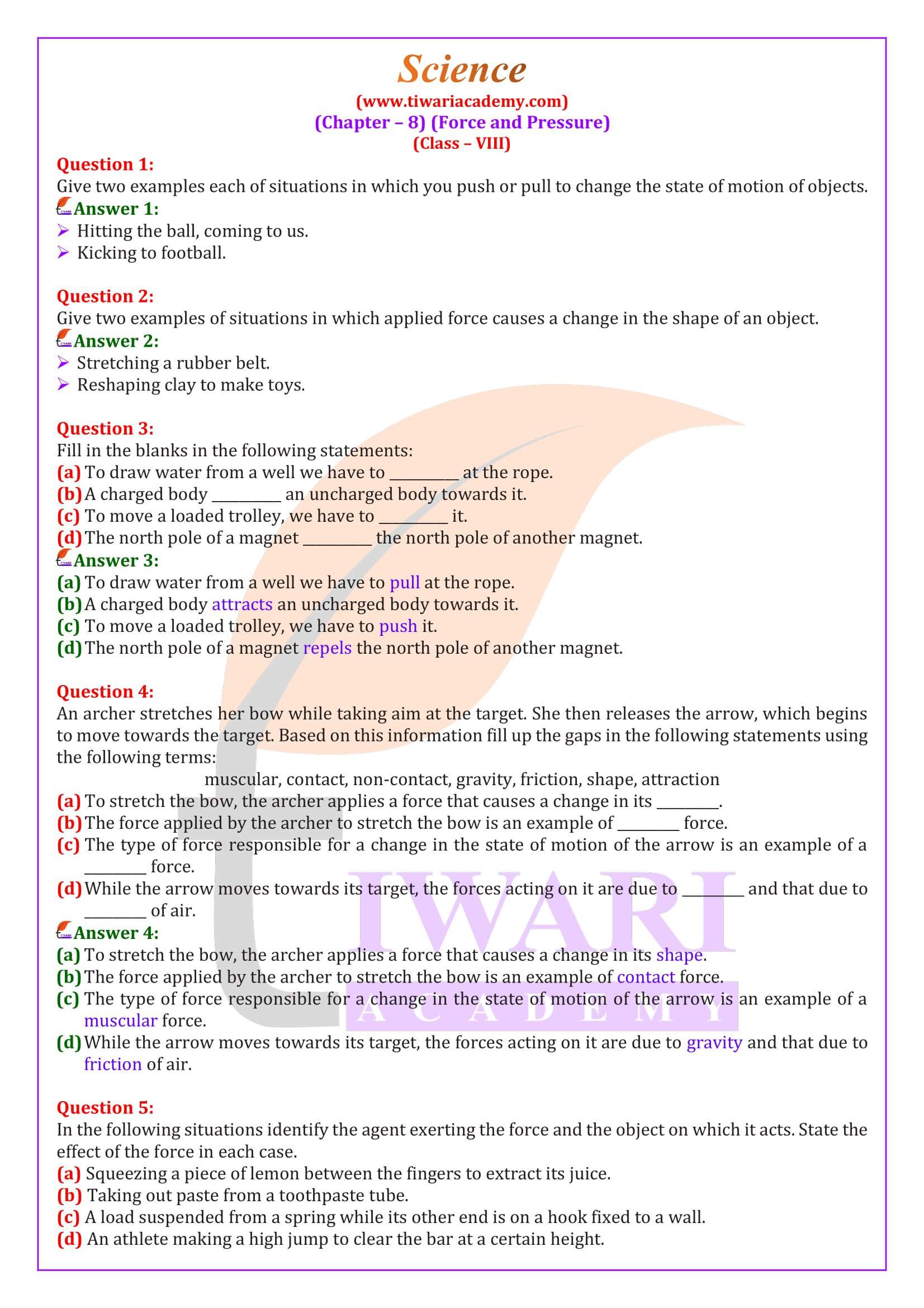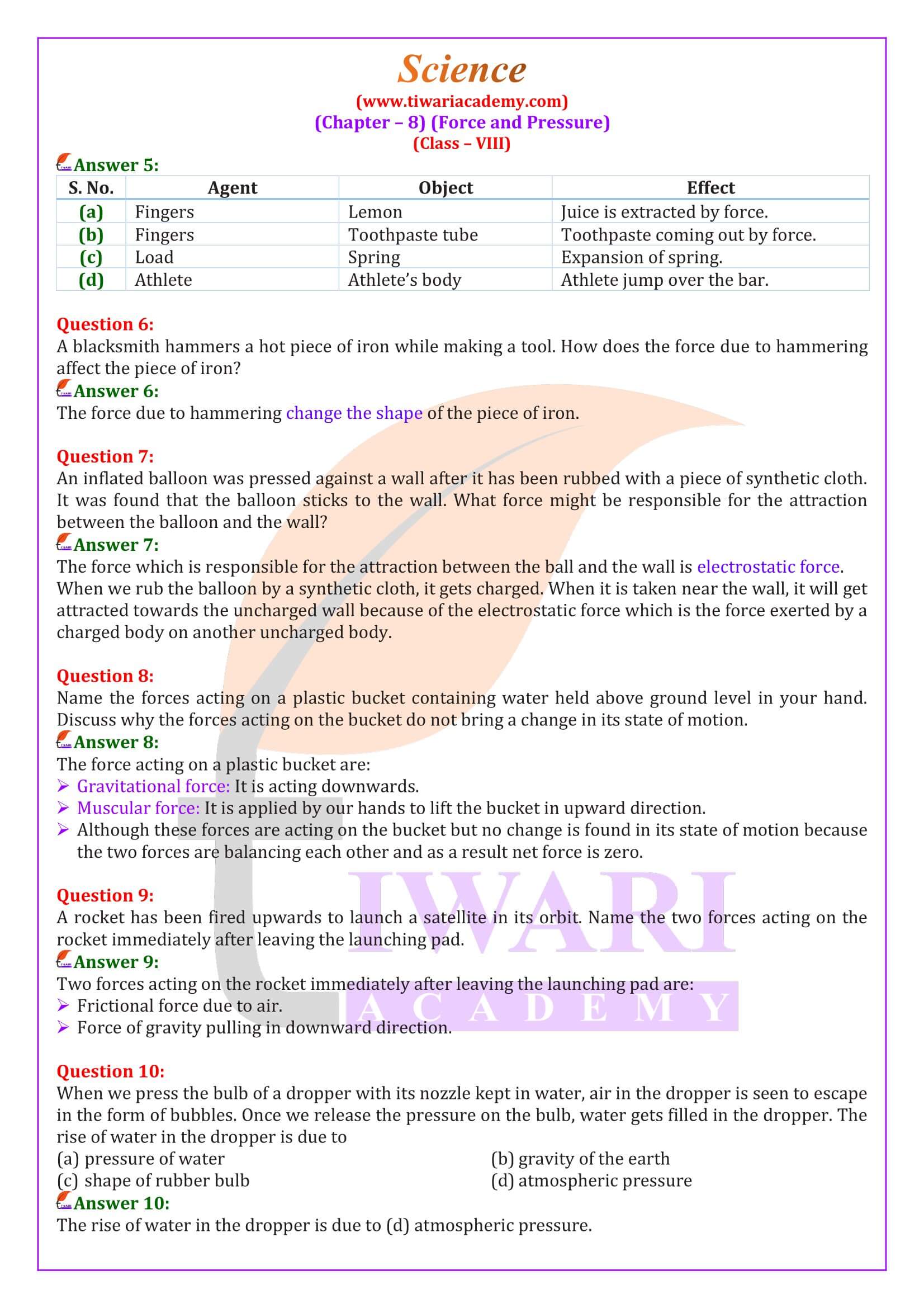Question Wise Class 8 Science Chapter 8 Solutions
Class 8 Science Chapter 8 NCERT Answers
Class 8 Science Chapter 8 in Hindi Medium
Class 8 Science Chapter 8 Extra Questions
Class 8 Science Chapter 8 MCQ
Class 8 Science NCERT Book Download
Class 8 Science Chapter 8 Exemplar Book
Class 8 Science Chapter 8 Exemplar Answers
NCERT Solutions for Class 8 Science Chapter 8 Force and Pressure English and Hindi Medium PDF and Video Format modified for session 2024-25. Solutions are based on new NCERT Books issued for academic year 2024-25. CBSE NCERT Sols and Offline Apps are updated for new academic session. Not only 8th Science solutions but other subjects are also available.
| Class: 8 | Science |
| Chapter 8: | Force and Pressure |
| Content: | NCERT Solutios, Extra Questions and MCQ |
| Session: | 2024-25 |
| Medium: | Hindi and English Medium |
Class 8 Science Chapter 8 NCERT Solutions
- Class 8 Science Chapter 8 Question Answers
- Class 8 Science Chapter 8 in Hindi Medium
- Class 8 Science Chapter 8 Extra Questions
- Class 8 Science Chapter 8 MCQ
- Class 8 Science Chapter 8 NCERT Book
- Class 8 Science Chapter 8 Exemplar Book
- Class 8 Science Chapter 8 Exemplar Answers
- Class 8 Science NCERT Solutions
- Class 8 all Subjects NCERT Solutions
Class 8 Science Chapter 8 Solution and Explanation in Hindi
Class 8 Science Chapter 8 Answers
NCERT Solutions for Class 8 Science Chapter 8 Force and Pressure is given below updated for new session in English Medium. Video Format solutions of all chapters are also available. Download 8 Science App for offline use.
Class 8 Science Chapter 8 Important Questions for Practice
A rocket has been fired upwards to launch a satellite in its orbit. Name the two forces acting on the rocket immediately after leaving the launching pad.
Two forces acting on the rocket immediately after leaving the launching pad are:
Frictional force due to air.
Force of gravity pulling in downward direction.
An inflated balloon was pressed against a wall after it has been rubbed with a piece of synthetic cloth. It was found that the balloon sticks to the wall. What force might be responsible for the attraction between the balloon and the wall?
The force which is responsible for the attraction between the ball and the wall is electrostatic force.
When we rub the balloon by a synthetic cloth, it gets charged. When it is taken near the wall, it will get attracted towards the uncharged wall because of the electrostatic force which is the force exerted by a charged body on another uncharged body.
A blacksmith hammers a hot piece of iron while making a tool. How does the force due to hammering affect the piece of iron?
The force due to hammering change the shape of the piece of iron.
Name the forces acting on a plastic bucket containing water held above ground level in your hand. Discuss why the forces acting on the bucket do not bring a change in its state of motion.
The force acting on a plastic bucket are:
Gravitational force: It is acting downwards.
Muscular force: It is applied by our hands to lift the bucket in upward direction.
Although these forces are acting on the bucket but no change is found in its state of motion because the two forces are balancing each other and as a result net force is zero.
Class 8 Science Chapter 8 Solution and Explanation
Class 8 Science Chapter 8 MCQ with Answers
1. Two objects repel each other. This repulsion could be due to
(a) frictional force only
(b) electrostatic force only
(c) magnetic force only
(d) either a magnetic or an electrostatic force
2. During dry weather, while combing hair, sometimes we experience hair flying apart. The force responsible for this is
(a) force of gravity.
(b) electrostatic force.
(c) force of friction.
(d) magnetic force.
3. Which one of the following forces is a contact force?
(a) force of gravity
(b) force of friction
(c) magnetic force
(d) electrostatic force
4. A ball of dough is rolled into a flat chapatti. Name the force exerted to change the shape of the dough.
5. A girl is pushing a box towards east direction. In which direction should her friend push the box so that it moves faster in the same direction?
6. During dry weather, clothes made of synthetic fibre often stick to the skin. Which type of force is responsible for this phenomenon?
7. A gas filled balloon moves up. Is the upward force acting on it larger or smaller than the force of gravity?
8. A chapati maker is a machine which converts balls of dough into chapati’s. What effect of force comes into play in this process?
9. Two persons are applying forces on two opposite sides of a moving cart. The cart still moves with the same speed in the same direction. What do you infer about the magnitudes and direction of the forces applied.
10. Fruits detached from a tree fall down due to force of gravity. We know that a force arises due to interaction between two objects. Name the objects interacting in this case.
Answers of Important Questions
1 (d)
2 (b)
3 (b)
4 Muscular force.
5 Towards east.
6 Electrostatic force.
7 Upward force is larger than the force of gravity.
8 The force changes the shape of the dough.
9 Both the forces are of equal magnitudes and applied in the opposite directions.
10 Earth and fruits.
Download NCERT Books and Offline Apps 2024-25 based on new CBSE Syllabus. Ask your doubts related to NIOS or CBSE Board and share your knowledge with your friends and other users through Discussion Forum.




